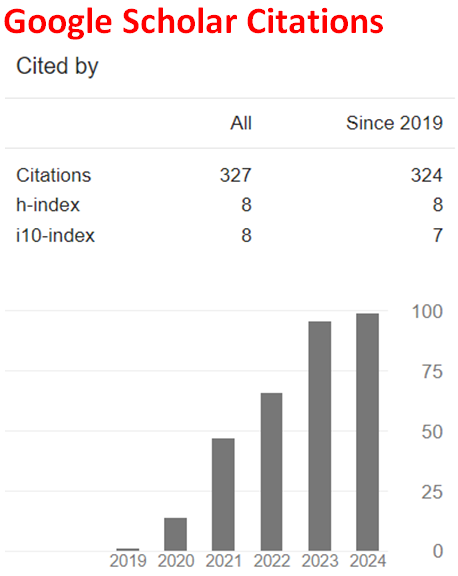Some Curcumin Isomers and Their Enol Tautomers - A DFT Treatment
Abstract
Curcumin is a well known natural product having some health benefits. In the present study, within the constraints of density functional theory (at the level of B3LYP/6-31G(d,p)), some configurational isomers of curcumin and their keto-enol tautomers have been investigated. Some quantum chemical, QSAR and spectral data of them have been obtained and discussed.
References
K.I. Priyadarsini, The chemistry of curcumin: From extraction to therapeutic agent, Molecules 19 (2014), 20091-20112. https://doi.org/10.3390/molecules191220091
L.E. Wright, J.B. Frye, B. Gorti, B.N. Timmermann and J.L. Funk, Bioactivity of turmeric-derived curcuminoids and related metabolites in breast cancer, Curr. Pharm. Des. 19 (2013), 6218-6225. https://doi.org/10.2174/1381612811319340013
S.J. Hewlings and D.S. Kalman, Curcumin: A review of its’ effects on human health, Foods 6(10) (2017), 92/1-92/11. https://doi.org/10.3390/foods6100092
B.B. Aggarwal and K.B. Harikumar, Potential therapeutic effects of curcumin, the anti-inflammatory agent, against neurodegenerative, cardiovascular, pulmonary, metabolic, autoimmune and neoplastic diseases, Int. J. Biochem. Cell Biol. 41 (2009), 40-59. https://doi.org/10.1016/j.biocel.2008.06.010
B.B. Aggarwal, A. Kumar and A.C. Bharti, Anticancer potential of curcumin: Preclinical and clinical studies, Anticancer Res. 23 (2003), 363-398.
P. Basnet and N.S. Basnet, Curcumin: An anti-inflammatory molecule from a curry spice on the path to cancer treatment, Molecules 16 (2011), 4567-4598. https://doi.org/10.3390/molecules16064567
A.B. Kunnumakkara, D. Bordoloi, C. Harsha, K. Banik, S.C. Gupta and B.B. Aggarwal, Curcumin mediates anticancer effects by modulating multiple cell signaling pathways, Clin. Sci. 131 (2017), 1781-1799. https://doi.org/10.1042/CS20160935
Y.G. Lin, A.B. Kunnumakkara, A. Nair, W.M. Merritt, L.Y. Han, G.N.A. Pena, A.A. Kamat, W.A. Spannuth, D.M. Gershenson, S.K. Lutgendorf, B.B. Aggarwal and A.K. Sood, Curcumin inhibits tumor growth and angiogenesis in ovarian carcinoma by targeting the nuclear factor-κB pathway, Clin. Cancer Res. 13 (2007), 3423-3430. https://doi.org/10.1158/1078-0432.CCR-06-3072
G.B. Mahady, S.L. Pendland, G. Yun and Z.Z. Lu, Turmeric (Curcuma longa) and curcumin inhibit the growth of Helicobacter pylori, a group 1 carcinogen, Anticancer Res. 22 (2002), 4179-4181.
Y. Panahi, M.S. Hosseini, N. Khalili, E. Naimi, L.E.S. Mendia, M. Majeed and A. Sahebkar, Effects of curcumin on serum cytokine concentrations in subjects with metabolic syndrome: A post-hoc analysis of a randomized controlled trial, Biomed. Pharmacother. 82 (2016), 578-582. https://doi.org/10.1016/j.biopha.2016.05.037
H.K. Han, The effects of black pepper on the intestinal absorption and hepatic metabolism of drugs, Expert Opin. Drug Metab. Toxicol. 7 (2011), 721-729. https://doi.org/10.1517/17425255.2011.570332
G. Shoba, D. Joy, T. Joseph, M. Majeed, R. Rajendran and P.S. Srinivas, Influence of piperine on the pharmacokinetics of curcumin in animals and human volunteers, Planta Med. 64 (1998), 353-356. https://doi.org/10.1055/s-2006-957450
A. Marchiani, C. Rozzo, A. Fadda, G. Delogu and P. Ruzza, Curcumin and curcumin-like molecules: From spice to drugs, Curr. Med. Chem. 21 (2014), 204-222. https://doi.org/10.2174/092986732102131206115810
Y. Panahi, G.H. Alishiri, S. Parvin and A. Sahebkar, Mitigation of systemic oxidative stress by curcuminoids in osteoarthritis: Results of a randomized controlled trial, J. Diet. Suppl. 13 (2016), 209-220. https://doi.org/10.3109/19390211.2015.1008611
M.L. Lestari and G. Indrayanto, Curcumin, Ch.3 (39, 113-204), Profiles Drug Subst. Excip. Relat. Methodol., Amsterdam: Elsevier, 2014. https://doi.org/10.1016/B978-0-12-800173-8.00003-9
R.C. Reddy, P.G. Vatsala, V.G. Keshamouni, G. Padmanaban and P.N. Rangarajan, Curcumin for malaria therapy, Biochem. Biophys. Res. Commun. 326 (2005), 472-474. https://doi.org/10.1016/j.bbrc.2004.11.051
L.V. Ramirez, P.P. Lopez, A.V. Lopez, M.R. Tortosa, M. Battino and J.L. Quiles, Curcumin and liver disease, Biofactors 39 (2013), 88-100. https://doi.org/10.1002/biof.1057
M.C. Fadus, C. Lau, J. Bikhchandani and H.T. Lynch, Curcumin: An age-old anti-inflammatory and anti-neoplastic agent, Journal of Traditional and Complementary Medicine 7 (2017) 339-346. https://doi.org/10.1016/j.jtcme.2016.08.002
K.I. Priyadarsini, D.K. Maity, G.H. Naik, M.S. Kumar, M.K. Unnikrishnan, J.G. Satav and H. Mohan, Role of phenolic O-H and methylene hydrogen on the free radical reactions and antioxidant activity of curcumin, Free Radic. Biol. Med. 35 (2003), 475-484. https://doi.org/10.1016/s0891-5849(03)00325-3
J.J.P. Stewart, Optimization of parameters for semiempirical methods I. Method, J. Comput. Chem. 10 (1989), 209-220. https://doi.org/10.1002/jcc.540100208
J.J.P. Stewart, Optimization of parameters for semi empirical methods II. Application, J. Comput. Chem. 10 (1989), 221-264. https://doi.org/10.1002/jcc.540100209
A.R. Leach, Molecular Modeling, Essex: Longman, 1997.
P. Fletcher, Practical Methods of Optimization, New York: Wiley, 1990.
W. Kohn and L. Sham, Self-consistent equations including exchange and correlation effects, J. Phys. Rev. 140 (1965), 1133-1138. https://doi.org/10.1103/PhysRev.140.A1133
R.G. Parr and W. Yang, Density Functional Theory of Atoms and Molecules, London: Oxford University Press, 1989.
A.D. Becke, Density-functional exchange-energy approximation with correct asymptotic behavior, Phys. Rev. A 38 (1988), 3098-3100. https://doi.org/10.1103/PhysRevA.38.3098
S.H. Vosko, L. Vilk and M. Nusair, Accurate spin-dependent electron liquid correlation energies for local spin density calculations: a critical analysis, Can. J. Phys. 58 (1980), 1200-1211. https://doi.org/10.1139/p80-159
C. Lee, W. Yang and R.G. Parr, Development of the Colle-Salvetti correlation-energy formula into a functional of the electron density, Phys. Rev. B 37 (1988), 785-789. https://doi.org/10.1103/PhysRevB.37.785
SPARTAN 06, Wavefunction Inc., Irvine CA, USA, 2006.
I. Fleming, Frontier Orbitals and Organic Chemical Reactions, London: Wiley, 1976.

This work is licensed under a Creative Commons Attribution 4.0 International License.


